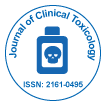
Journal of Clinical Toxicology
Open Access
ISSN: 2161-0495
+44 1478 350008

ISSN: 2161-0495
+44 1478 350008
Nadezhda I Fedotcheva, Valeri A Bykov, Viktor V Banin, Tatyana A Fedotcheva, Vladimir M. Rzheznikov and Nikolai L Shimanovskii
The problem of multidrug resistance has been intensively studied during the last decade. It is known that some synthetic progestins can chemosensitize tumor cells to cytostatic drugs; however, the mechanisms of the sensitization are not clearly understood. In this study, the effect of synthetic analogue of progesterone (17α-acetoxy- 3b-butanoyloxy-6-methyl-pregna-4, 6-diene-20-on, buterol) on the survival of doxorubicin-resistant MCF-7 cells and the coupling of isolated mitochondria was investigated in comparison with the thiol reagent N-ethylmaleimide (NEM). Both compounds increased the doxorubicin-induced cell death and decreased the oxidative phosphorylation and the coupling in mitochondria; their presence was necessary for the direct action of doxorubicin on the mitochondrial membrane potential. Possible specific targets for NEM and buterol are the SH-groups of mitochondrial ATPase and the nucleotide-binding domain of MDR proteins, owing to which they inhibit the activity of both ATPase and MDR proteins and increase the accumulation of drugs in the cell. In addition, buterol can form hydrogen bonds between its ether carbonyl at carbon C3 and some other thiols, thereby inducing oxidative stress. By contrast to NEM, which irreversibly blocks thiol groups, buterol binds thiols non-covalently, which provides a new useful approach to the enhancement of the anticancer activity of cytostatics in tumor cells.